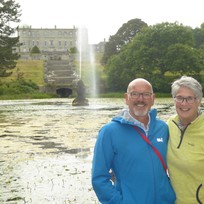( Overview
/ Two Scilly Bullocks on a Boat
Dartmouth Castle, an artillery fort, built in the 1380s in response to the threat of a French attack, incorporated the local chapel of Saint Petroc within its walls. In the 15th century it was expanded, and also had an iron chain across to a tower at Godmerock which could be raised.
…whilst the other kept watch, mainly for lobster pots. There were more sailing boats on the water than we’ve seen in years…
…and of course fishing vessels. This one laying those pesky pots. At least these marker buoys are orange, not black or white, which are hard to see on the water.
The Isle of Portland is a small island, joined to mainland England by Chesil Beach. Portland stone, famous for its use in St Paul’s Cathedral and world architecture continues to be mined here. Portland Bill is the narrow promontory at the southern end on which stands the lighthouse, built in 1906.
The inner passage of Portland Bill has a tidal race which has been described as the most dangerous area of broken water in the English Channel - caused by clashing tides and exacerbated by reduced depths over Portland Ledge. We kept well clear, but our speed helpfully increased to over 10 knots.
We were motor sailing to make sure we made good time, but, the tide being with us, we were able to sail for a while goose-winged, the wind behind us. Kevin was worried our bilges were filling, and with no pump he needed to empty them by hand - not possible with the engine running, and prop turning.
Having had the brilliant idea of swapping the pump from the holding tank, Kevin tried to do this at sea, but, as with all things on a boat, space is restricted, access difficult, and nuts and bolts stuck. On investigation, too, the bilges weren’t as full as he’d suspected.
Lulworth Cove, on the Jurassic Coast, is part of a five mile stretch of coastline which includes Durdle Door; a World Heritage Site, the historic Lulworth Estate and castle is owned by the Weld family.
Anvil Point Lighthouse on Durlston Head is 39 feet tall and built in 1881. The cottages are let out for holidays.
Old Harry Rocks are three chalk formations, including a stack and a stump, located at Handfast Point on the Isle of Purbeck. They are part of the Jurassic Coast World Heritage Site.
Although known as Old Harry Rocks, the name actually refers to the single stack furthest our to sea. Until 1896 there was another stack known as Old Harry’s Wife, but erosion caused her to tumble, leaving just a stump.
There are numerous legends about the origin of the name. One says the devil ‘Old Harry’ slept on the rocks, another local legend says the rocks were named after Harry Paye, the infamous Poole pirate, and yet another that Earl Harry drowned during a Viking raid thwarted by a storm in the 9th century.
Bramble Bush Bay chain ferry came into service in 1994. It crosses the entrance to Poole Harbour between Sandbanks and Shell Bay. The ferry, 242 feet in length, has a nominal capacity of 48 cars, and runs almost continuously, so coming up the channel has to be timed precisely to avoid a collision!































 Sign in with Apple
Sign in with Apple  Log in with Facebook
Log in with Facebook